Entrepreneurship and Small Business Management Report - BTEC Level 5
VerifiedAdded on 2022/11/30
|18
|5559
|430
Report
AI Summary
This report delves into the multifaceted world of entrepreneurship and small business management. It begins by defining entrepreneurship and exploring different types of entrepreneurial ventures, including small, large, scalable, and social enterprises, and examines how they relate to the typology of entrepreneurship. The report further identifies the similarities and differences between these ventures. The analysis includes interpreting and assessing data and statistics to illustrate the impact of micro and small businesses on the economy, emphasizing their importance to the growth of the social economy. It also explores the characteristics, traits, and skills of successful entrepreneurs, as well as the impact of background and experience. Through detailed examination and analysis, the report provides a comprehensive understanding of entrepreneurship and its role in the economy, supported by examples and data.

Entrepreneurship and
small business
management
small business
management
Paraphrase This Document
Need a fresh take? Get an instant paraphrase of this document with our AI Paraphraser
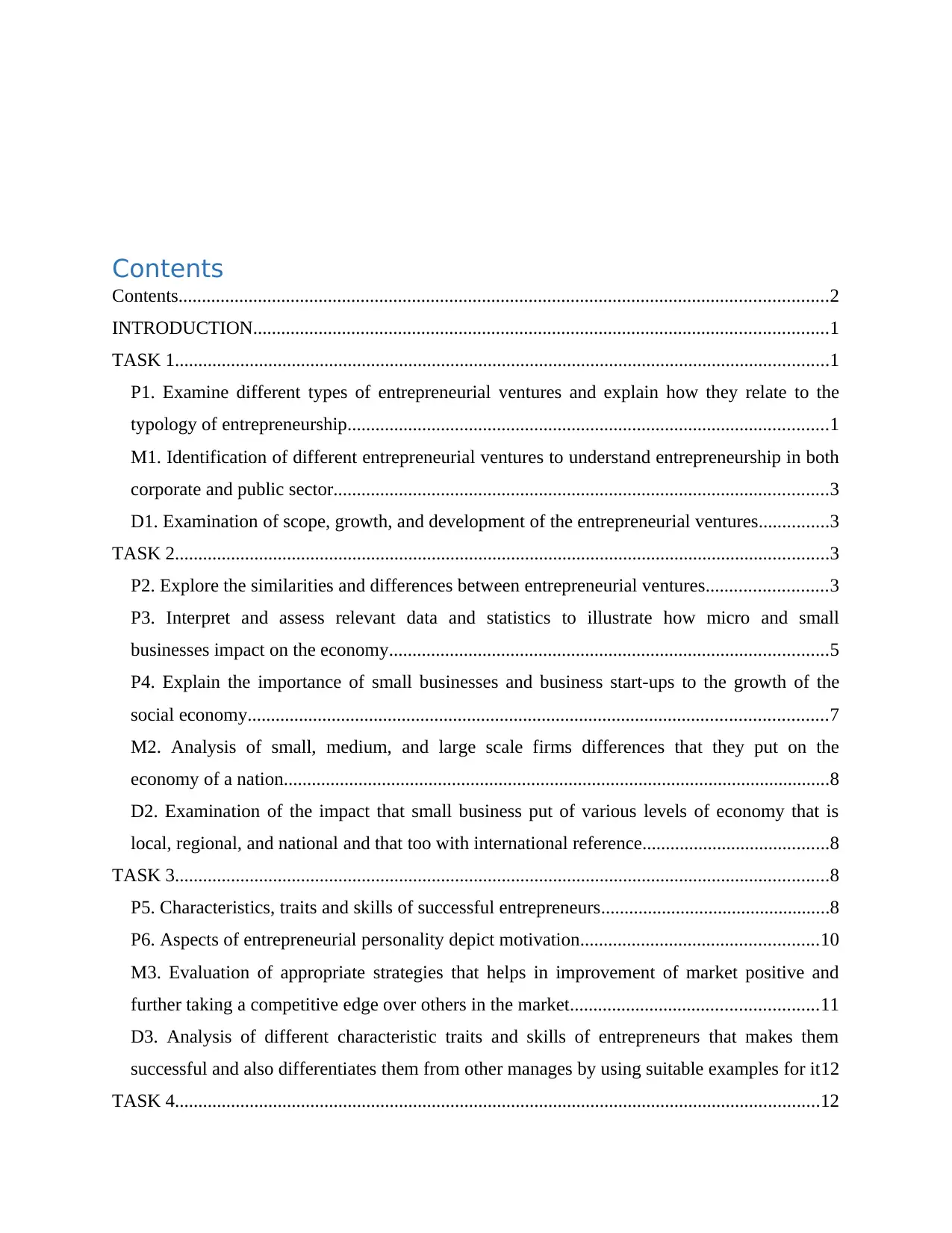
Contents
Contents...........................................................................................................................................2
INTRODUCTION...........................................................................................................................1
TASK 1............................................................................................................................................1
P1. Examine different types of entrepreneurial ventures and explain how they relate to the
typology of entrepreneurship.......................................................................................................1
M1. Identification of different entrepreneurial ventures to understand entrepreneurship in both
corporate and public sector..........................................................................................................3
D1. Examination of scope, growth, and development of the entrepreneurial ventures...............3
TASK 2............................................................................................................................................3
P2. Explore the similarities and differences between entrepreneurial ventures..........................3
P3. Interpret and assess relevant data and statistics to illustrate how micro and small
businesses impact on the economy..............................................................................................5
P4. Explain the importance of small businesses and business start-ups to the growth of the
social economy............................................................................................................................7
M2. Analysis of small, medium, and large scale firms differences that they put on the
economy of a nation.....................................................................................................................8
D2. Examination of the impact that small business put of various levels of economy that is
local, regional, and national and that too with international reference........................................8
TASK 3............................................................................................................................................8
P5. Characteristics, traits and skills of successful entrepreneurs.................................................8
P6. Aspects of entrepreneurial personality depict motivation...................................................10
M3. Evaluation of appropriate strategies that helps in improvement of market positive and
further taking a competitive edge over others in the market.....................................................11
D3. Analysis of different characteristic traits and skills of entrepreneurs that makes them
successful and also differentiates them from other manages by using suitable examples for it12
TASK 4..........................................................................................................................................12
Contents...........................................................................................................................................2
INTRODUCTION...........................................................................................................................1
TASK 1............................................................................................................................................1
P1. Examine different types of entrepreneurial ventures and explain how they relate to the
typology of entrepreneurship.......................................................................................................1
M1. Identification of different entrepreneurial ventures to understand entrepreneurship in both
corporate and public sector..........................................................................................................3
D1. Examination of scope, growth, and development of the entrepreneurial ventures...............3
TASK 2............................................................................................................................................3
P2. Explore the similarities and differences between entrepreneurial ventures..........................3
P3. Interpret and assess relevant data and statistics to illustrate how micro and small
businesses impact on the economy..............................................................................................5
P4. Explain the importance of small businesses and business start-ups to the growth of the
social economy............................................................................................................................7
M2. Analysis of small, medium, and large scale firms differences that they put on the
economy of a nation.....................................................................................................................8
D2. Examination of the impact that small business put of various levels of economy that is
local, regional, and national and that too with international reference........................................8
TASK 3............................................................................................................................................8
P5. Characteristics, traits and skills of successful entrepreneurs.................................................8
P6. Aspects of entrepreneurial personality depict motivation...................................................10
M3. Evaluation of appropriate strategies that helps in improvement of market positive and
further taking a competitive edge over others in the market.....................................................11
D3. Analysis of different characteristic traits and skills of entrepreneurs that makes them
successful and also differentiates them from other manages by using suitable examples for it12
TASK 4..........................................................................................................................................12

P7: Background and Experience can hinder or foster Entrepreneurship...................................12
M4. Identification of the link between various entrepreneurial characteristics and the level of
influence that experience and personal background put on successful entrepreneurs...............13
D4. Detailed evaluation and analysis of the factors that is background and experience and their
impact on entrepreneurs in both positive and negative aspect..................................................13
CONCLUSION..............................................................................................................................14
REFERENCES..............................................................................................................................15
M4. Identification of the link between various entrepreneurial characteristics and the level of
influence that experience and personal background put on successful entrepreneurs...............13
D4. Detailed evaluation and analysis of the factors that is background and experience and their
impact on entrepreneurs in both positive and negative aspect..................................................13
CONCLUSION..............................................................................................................................14
REFERENCES..............................................................................................................................15
⊘ This is a preview!⊘
Do you want full access?
Subscribe today to unlock all pages.

Trusted by 1+ million students worldwide
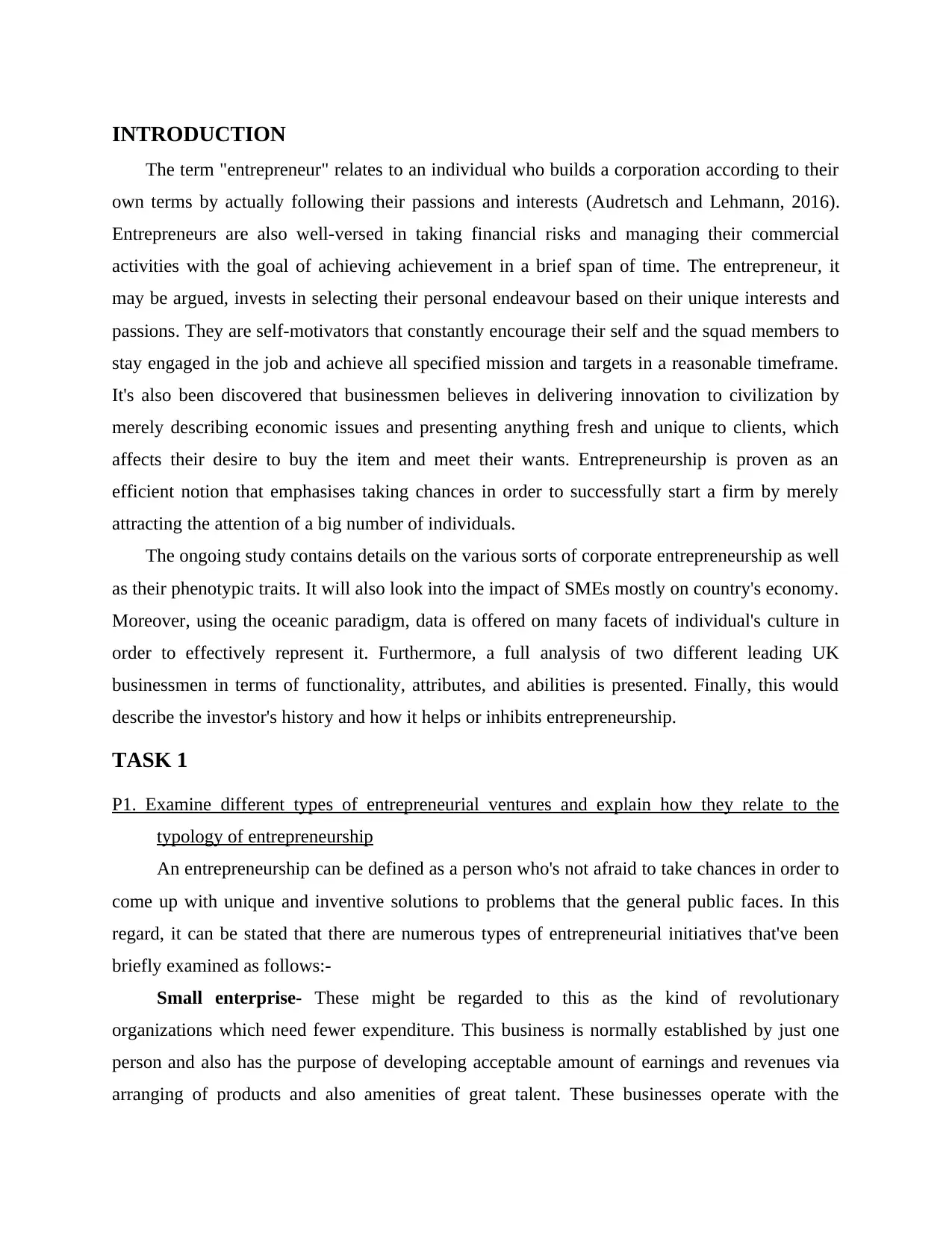
INTRODUCTION
The term "entrepreneur" relates to an individual who builds a corporation according to their
own terms by actually following their passions and interests (Audretsch and Lehmann, 2016).
Entrepreneurs are also well-versed in taking financial risks and managing their commercial
activities with the goal of achieving achievement in a brief span of time. The entrepreneur, it
may be argued, invests in selecting their personal endeavour based on their unique interests and
passions. They are self-motivators that constantly encourage their self and the squad members to
stay engaged in the job and achieve all specified mission and targets in a reasonable timeframe.
It's also been discovered that businessmen believes in delivering innovation to civilization by
merely describing economic issues and presenting anything fresh and unique to clients, which
affects their desire to buy the item and meet their wants. Entrepreneurship is proven as an
efficient notion that emphasises taking chances in order to successfully start a firm by merely
attracting the attention of a big number of individuals.
The ongoing study contains details on the various sorts of corporate entrepreneurship as well
as their phenotypic traits. It will also look into the impact of SMEs mostly on country's economy.
Moreover, using the oceanic paradigm, data is offered on many facets of individual's culture in
order to effectively represent it. Furthermore, a full analysis of two different leading UK
businessmen in terms of functionality, attributes, and abilities is presented. Finally, this would
describe the investor's history and how it helps or inhibits entrepreneurship.
TASK 1
P1. Examine different types of entrepreneurial ventures and explain how they relate to the
typology of entrepreneurship
An entrepreneurship can be defined as a person who's not afraid to take chances in order to
come up with unique and inventive solutions to problems that the general public faces. In this
regard, it can be stated that there are numerous types of entrepreneurial initiatives that've been
briefly examined as follows:-
Small enterprise- These might be regarded to this as the kind of revolutionary
organizations which need fewer expenditure. This business is normally established by just one
person and also has the purpose of developing acceptable amount of earnings and revenues via
arranging of products and also amenities of great talent. These businesses operate with the
The term "entrepreneur" relates to an individual who builds a corporation according to their
own terms by actually following their passions and interests (Audretsch and Lehmann, 2016).
Entrepreneurs are also well-versed in taking financial risks and managing their commercial
activities with the goal of achieving achievement in a brief span of time. The entrepreneur, it
may be argued, invests in selecting their personal endeavour based on their unique interests and
passions. They are self-motivators that constantly encourage their self and the squad members to
stay engaged in the job and achieve all specified mission and targets in a reasonable timeframe.
It's also been discovered that businessmen believes in delivering innovation to civilization by
merely describing economic issues and presenting anything fresh and unique to clients, which
affects their desire to buy the item and meet their wants. Entrepreneurship is proven as an
efficient notion that emphasises taking chances in order to successfully start a firm by merely
attracting the attention of a big number of individuals.
The ongoing study contains details on the various sorts of corporate entrepreneurship as well
as their phenotypic traits. It will also look into the impact of SMEs mostly on country's economy.
Moreover, using the oceanic paradigm, data is offered on many facets of individual's culture in
order to effectively represent it. Furthermore, a full analysis of two different leading UK
businessmen in terms of functionality, attributes, and abilities is presented. Finally, this would
describe the investor's history and how it helps or inhibits entrepreneurship.
TASK 1
P1. Examine different types of entrepreneurial ventures and explain how they relate to the
typology of entrepreneurship
An entrepreneurship can be defined as a person who's not afraid to take chances in order to
come up with unique and inventive solutions to problems that the general public faces. In this
regard, it can be stated that there are numerous types of entrepreneurial initiatives that've been
briefly examined as follows:-
Small enterprise- These might be regarded to this as the kind of revolutionary
organizations which need fewer expenditure. This business is normally established by just one
person and also has the purpose of developing acceptable amount of earnings and revenues via
arranging of products and also amenities of great talent. These businesses operate with the
Paraphrase This Document
Need a fresh take? Get an instant paraphrase of this document with our AI Paraphraser
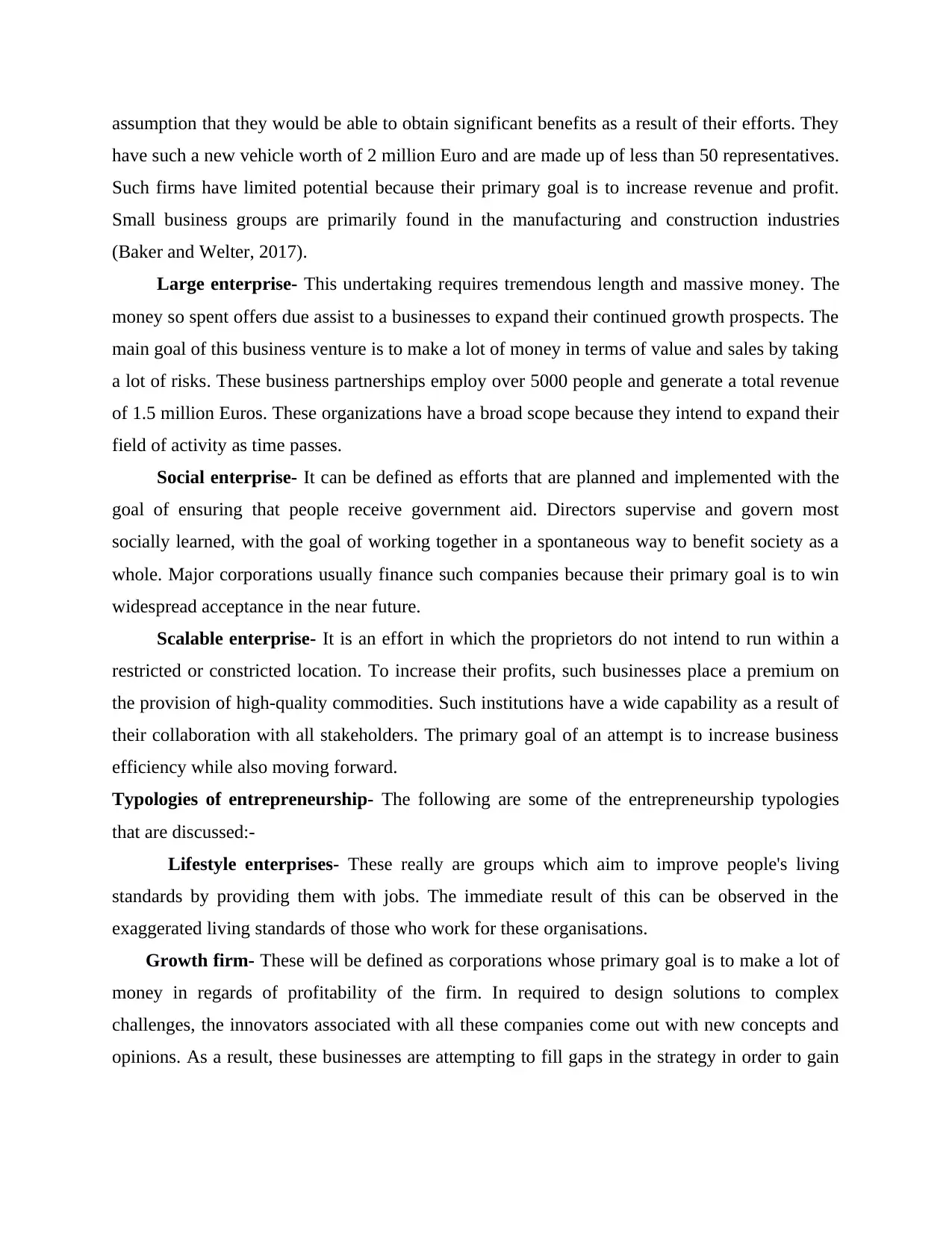
assumption that they would be able to obtain significant benefits as a result of their efforts. They
have such a new vehicle worth of 2 million Euro and are made up of less than 50 representatives.
Such firms have limited potential because their primary goal is to increase revenue and profit.
Small business groups are primarily found in the manufacturing and construction industries
(Baker and Welter, 2017).
Large enterprise- This undertaking requires tremendous length and massive money. The
money so spent offers due assist to a businesses to expand their continued growth prospects. The
main goal of this business venture is to make a lot of money in terms of value and sales by taking
a lot of risks. These business partnerships employ over 5000 people and generate a total revenue
of 1.5 million Euros. These organizations have a broad scope because they intend to expand their
field of activity as time passes.
Social enterprise- It can be defined as efforts that are planned and implemented with the
goal of ensuring that people receive government aid. Directors supervise and govern most
socially learned, with the goal of working together in a spontaneous way to benefit society as a
whole. Major corporations usually finance such companies because their primary goal is to win
widespread acceptance in the near future.
Scalable enterprise- It is an effort in which the proprietors do not intend to run within a
restricted or constricted location. To increase their profits, such businesses place a premium on
the provision of high-quality commodities. Such institutions have a wide capability as a result of
their collaboration with all stakeholders. The primary goal of an attempt is to increase business
efficiency while also moving forward.
Typologies of entrepreneurship- The following are some of the entrepreneurship typologies
that are discussed:-
Lifestyle enterprises- These really are groups which aim to improve people's living
standards by providing them with jobs. The immediate result of this can be observed in the
exaggerated living standards of those who work for these organisations.
Growth firm- These will be defined as corporations whose primary goal is to make a lot of
money in regards of profitability of the firm. In required to design solutions to complex
challenges, the innovators associated with all these companies come out with new concepts and
opinions. As a result, these businesses are attempting to fill gaps in the strategy in order to gain
have such a new vehicle worth of 2 million Euro and are made up of less than 50 representatives.
Such firms have limited potential because their primary goal is to increase revenue and profit.
Small business groups are primarily found in the manufacturing and construction industries
(Baker and Welter, 2017).
Large enterprise- This undertaking requires tremendous length and massive money. The
money so spent offers due assist to a businesses to expand their continued growth prospects. The
main goal of this business venture is to make a lot of money in terms of value and sales by taking
a lot of risks. These business partnerships employ over 5000 people and generate a total revenue
of 1.5 million Euros. These organizations have a broad scope because they intend to expand their
field of activity as time passes.
Social enterprise- It can be defined as efforts that are planned and implemented with the
goal of ensuring that people receive government aid. Directors supervise and govern most
socially learned, with the goal of working together in a spontaneous way to benefit society as a
whole. Major corporations usually finance such companies because their primary goal is to win
widespread acceptance in the near future.
Scalable enterprise- It is an effort in which the proprietors do not intend to run within a
restricted or constricted location. To increase their profits, such businesses place a premium on
the provision of high-quality commodities. Such institutions have a wide capability as a result of
their collaboration with all stakeholders. The primary goal of an attempt is to increase business
efficiency while also moving forward.
Typologies of entrepreneurship- The following are some of the entrepreneurship typologies
that are discussed:-
Lifestyle enterprises- These really are groups which aim to improve people's living
standards by providing them with jobs. The immediate result of this can be observed in the
exaggerated living standards of those who work for these organisations.
Growth firm- These will be defined as corporations whose primary goal is to make a lot of
money in regards of profitability of the firm. In required to design solutions to complex
challenges, the innovators associated with all these companies come out with new concepts and
opinions. As a result, these businesses are attempting to fill gaps in the strategy in order to gain
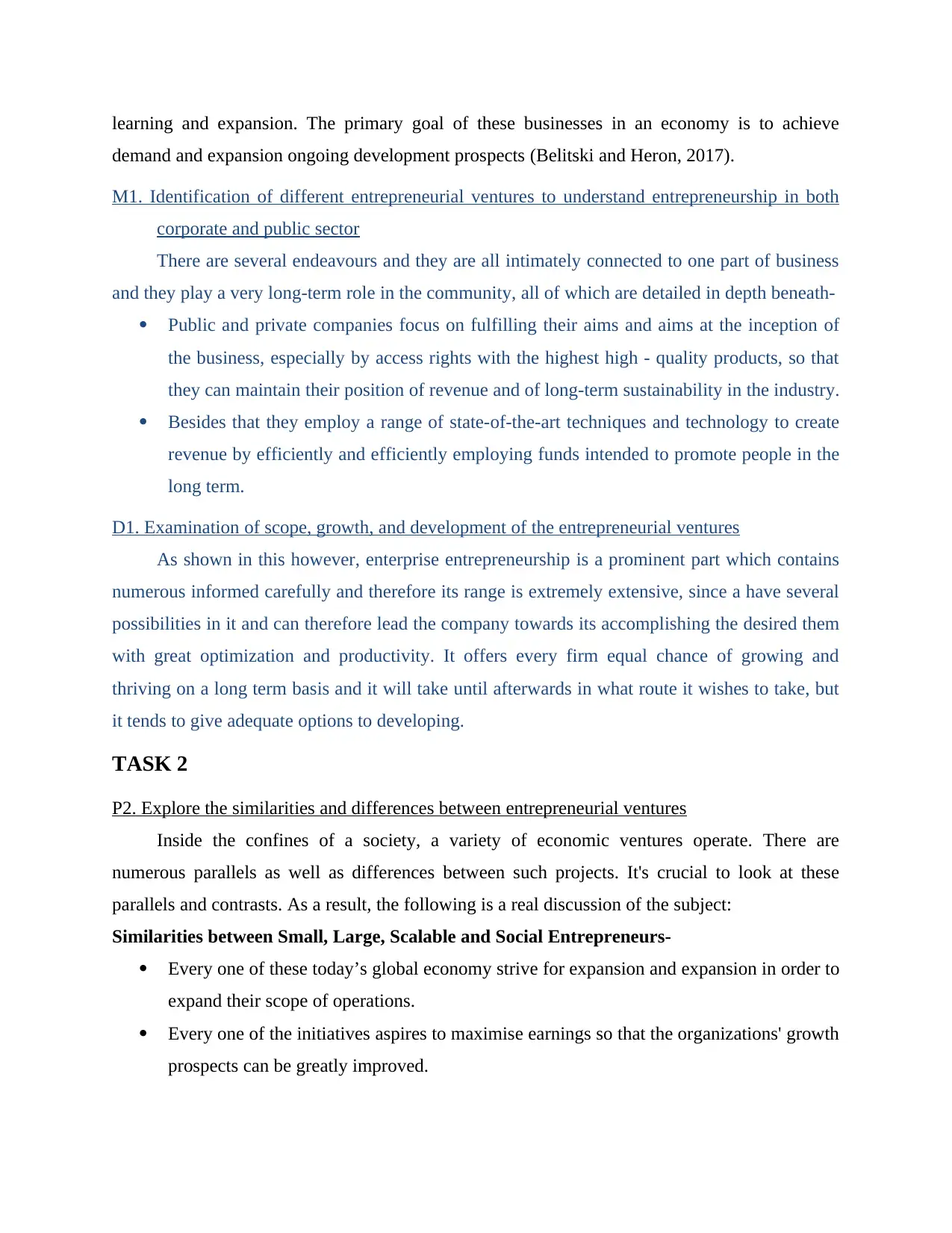
learning and expansion. The primary goal of these businesses in an economy is to achieve
demand and expansion ongoing development prospects (Belitski and Heron, 2017).
M1. Identification of different entrepreneurial ventures to understand entrepreneurship in both
corporate and public sector
There are several endeavours and they are all intimately connected to one part of business
and they play a very long-term role in the community, all of which are detailed in depth beneath-
Public and private companies focus on fulfilling their aims and aims at the inception of
the business, especially by access rights with the highest high - quality products, so that
they can maintain their position of revenue and of long-term sustainability in the industry.
Besides that they employ a range of state-of-the-art techniques and technology to create
revenue by efficiently and efficiently employing funds intended to promote people in the
long term.
D1. Examination of scope, growth, and development of the entrepreneurial ventures
As shown in this however, enterprise entrepreneurship is a prominent part which contains
numerous informed carefully and therefore its range is extremely extensive, since a have several
possibilities in it and can therefore lead the company towards its accomplishing the desired them
with great optimization and productivity. It offers every firm equal chance of growing and
thriving on a long term basis and it will take until afterwards in what route it wishes to take, but
it tends to give adequate options to developing.
TASK 2
P2. Explore the similarities and differences between entrepreneurial ventures
Inside the confines of a society, a variety of economic ventures operate. There are
numerous parallels as well as differences between such projects. It's crucial to look at these
parallels and contrasts. As a result, the following is a real discussion of the subject:
Similarities between Small, Large, Scalable and Social Entrepreneurs-
Every one of these today’s global economy strive for expansion and expansion in order to
expand their scope of operations.
Every one of the initiatives aspires to maximise earnings so that the organizations' growth
prospects can be greatly improved.
demand and expansion ongoing development prospects (Belitski and Heron, 2017).
M1. Identification of different entrepreneurial ventures to understand entrepreneurship in both
corporate and public sector
There are several endeavours and they are all intimately connected to one part of business
and they play a very long-term role in the community, all of which are detailed in depth beneath-
Public and private companies focus on fulfilling their aims and aims at the inception of
the business, especially by access rights with the highest high - quality products, so that
they can maintain their position of revenue and of long-term sustainability in the industry.
Besides that they employ a range of state-of-the-art techniques and technology to create
revenue by efficiently and efficiently employing funds intended to promote people in the
long term.
D1. Examination of scope, growth, and development of the entrepreneurial ventures
As shown in this however, enterprise entrepreneurship is a prominent part which contains
numerous informed carefully and therefore its range is extremely extensive, since a have several
possibilities in it and can therefore lead the company towards its accomplishing the desired them
with great optimization and productivity. It offers every firm equal chance of growing and
thriving on a long term basis and it will take until afterwards in what route it wishes to take, but
it tends to give adequate options to developing.
TASK 2
P2. Explore the similarities and differences between entrepreneurial ventures
Inside the confines of a society, a variety of economic ventures operate. There are
numerous parallels as well as differences between such projects. It's crucial to look at these
parallels and contrasts. As a result, the following is a real discussion of the subject:
Similarities between Small, Large, Scalable and Social Entrepreneurs-
Every one of these today’s global economy strive for expansion and expansion in order to
expand their scope of operations.
Every one of the initiatives aspires to maximise earnings so that the organizations' growth
prospects can be greatly improved.
⊘ This is a preview!⊘
Do you want full access?
Subscribe today to unlock all pages.

Trusted by 1+ million students worldwide
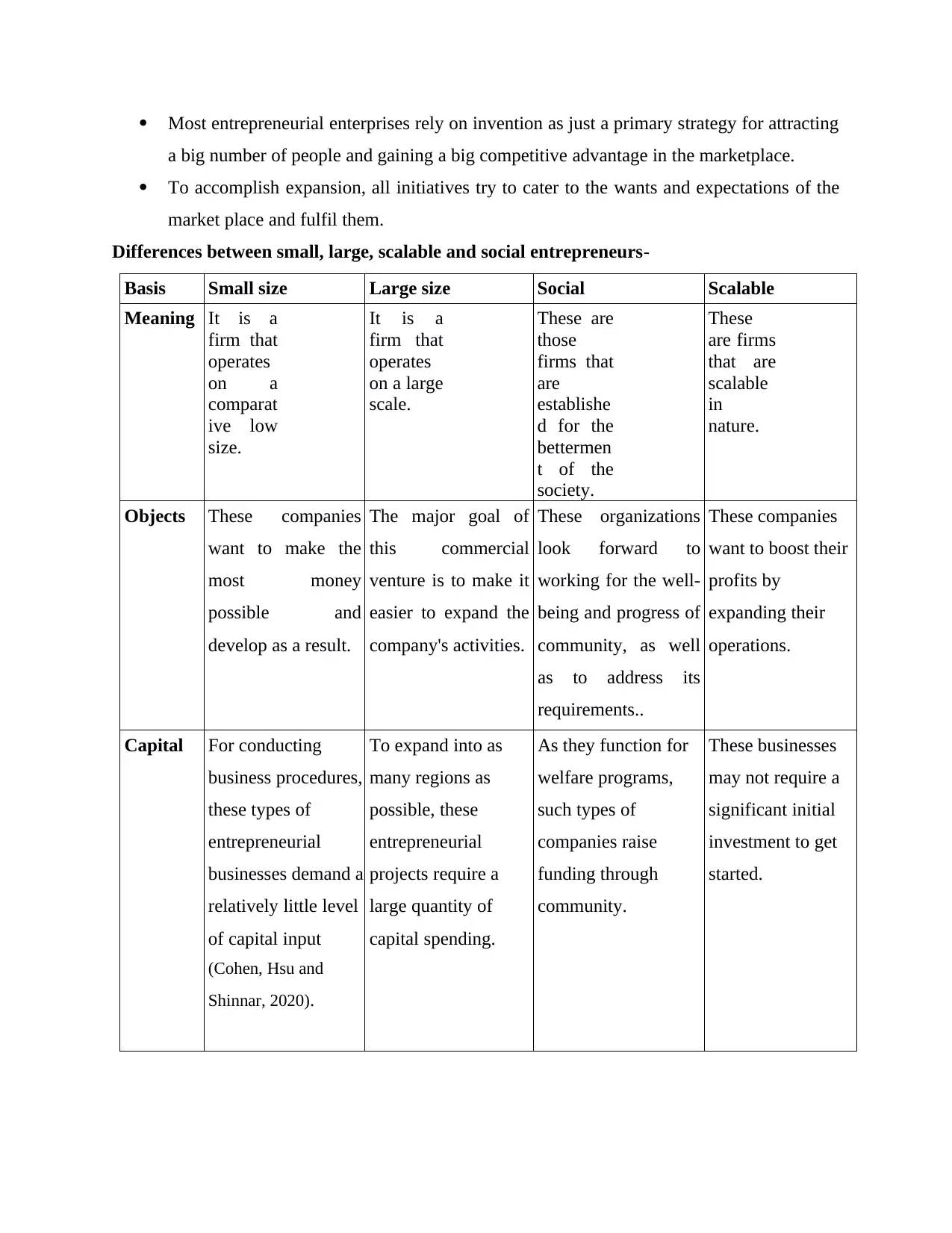
Most entrepreneurial enterprises rely on invention as just a primary strategy for attracting
a big number of people and gaining a big competitive advantage in the marketplace.
To accomplish expansion, all initiatives try to cater to the wants and expectations of the
market place and fulfil them.
Differences between small, large, scalable and social entrepreneurs-
Basis Small size Large size Social Scalable
Meaning It is a
firm that
operates
on a
comparat
ive low
size.
It is a
firm that
operates
on a large
scale.
These are
those
firms that
are
establishe
d for the
bettermen
t of the
society.
These
are firms
that are
scalable
in
nature.
Objects These companies
want to make the
most money
possible and
develop as a result.
The major goal of
this commercial
venture is to make it
easier to expand the
company's activities.
These organizations
look forward to
working for the well-
being and progress of
community, as well
as to address its
requirements..
These companies
want to boost their
profits by
expanding their
operations.
Capital For conducting
business procedures,
these types of
entrepreneurial
businesses demand a
relatively little level
of capital input
(Cohen, Hsu and
Shinnar, 2020).
To expand into as
many regions as
possible, these
entrepreneurial
projects require a
large quantity of
capital spending.
As they function for
welfare programs,
such types of
companies raise
funding through
community.
These businesses
may not require a
significant initial
investment to get
started.
a big number of people and gaining a big competitive advantage in the marketplace.
To accomplish expansion, all initiatives try to cater to the wants and expectations of the
market place and fulfil them.
Differences between small, large, scalable and social entrepreneurs-
Basis Small size Large size Social Scalable
Meaning It is a
firm that
operates
on a
comparat
ive low
size.
It is a
firm that
operates
on a large
scale.
These are
those
firms that
are
establishe
d for the
bettermen
t of the
society.
These
are firms
that are
scalable
in
nature.
Objects These companies
want to make the
most money
possible and
develop as a result.
The major goal of
this commercial
venture is to make it
easier to expand the
company's activities.
These organizations
look forward to
working for the well-
being and progress of
community, as well
as to address its
requirements..
These companies
want to boost their
profits by
expanding their
operations.
Capital For conducting
business procedures,
these types of
entrepreneurial
businesses demand a
relatively little level
of capital input
(Cohen, Hsu and
Shinnar, 2020).
To expand into as
many regions as
possible, these
entrepreneurial
projects require a
large quantity of
capital spending.
As they function for
welfare programs,
such types of
companies raise
funding through
community.
These businesses
may not require a
significant initial
investment to get
started.
Paraphrase This Document
Need a fresh take? Get an instant paraphrase of this document with our AI Paraphraser
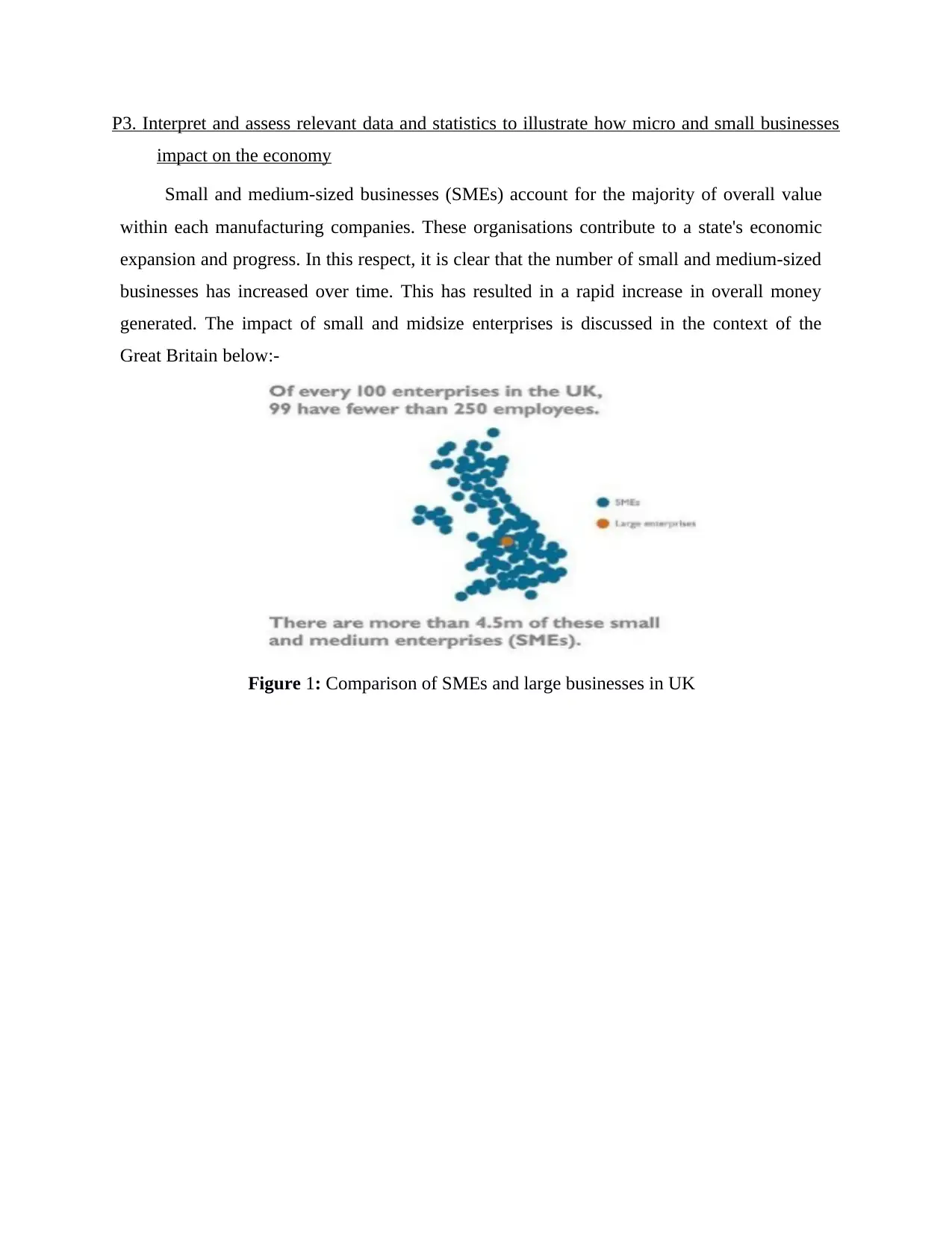
P3. Interpret and assess relevant data and statistics to illustrate how micro and small businesses
impact on the economy
Small and medium-sized businesses (SMEs) account for the majority of overall value
within each manufacturing companies. These organisations contribute to a state's economic
expansion and progress. In this respect, it is clear that the number of small and medium-sized
businesses has increased over time. This has resulted in a rapid increase in overall money
generated. The impact of small and midsize enterprises is discussed in the context of the
Great Britain below:-
Figure 1: Comparison of SMEs and large businesses in UK
impact on the economy
Small and medium-sized businesses (SMEs) account for the majority of overall value
within each manufacturing companies. These organisations contribute to a state's economic
expansion and progress. In this respect, it is clear that the number of small and medium-sized
businesses has increased over time. This has resulted in a rapid increase in overall money
generated. The impact of small and midsize enterprises is discussed in the context of the
Great Britain below:-
Figure 1: Comparison of SMEs and large businesses in UK
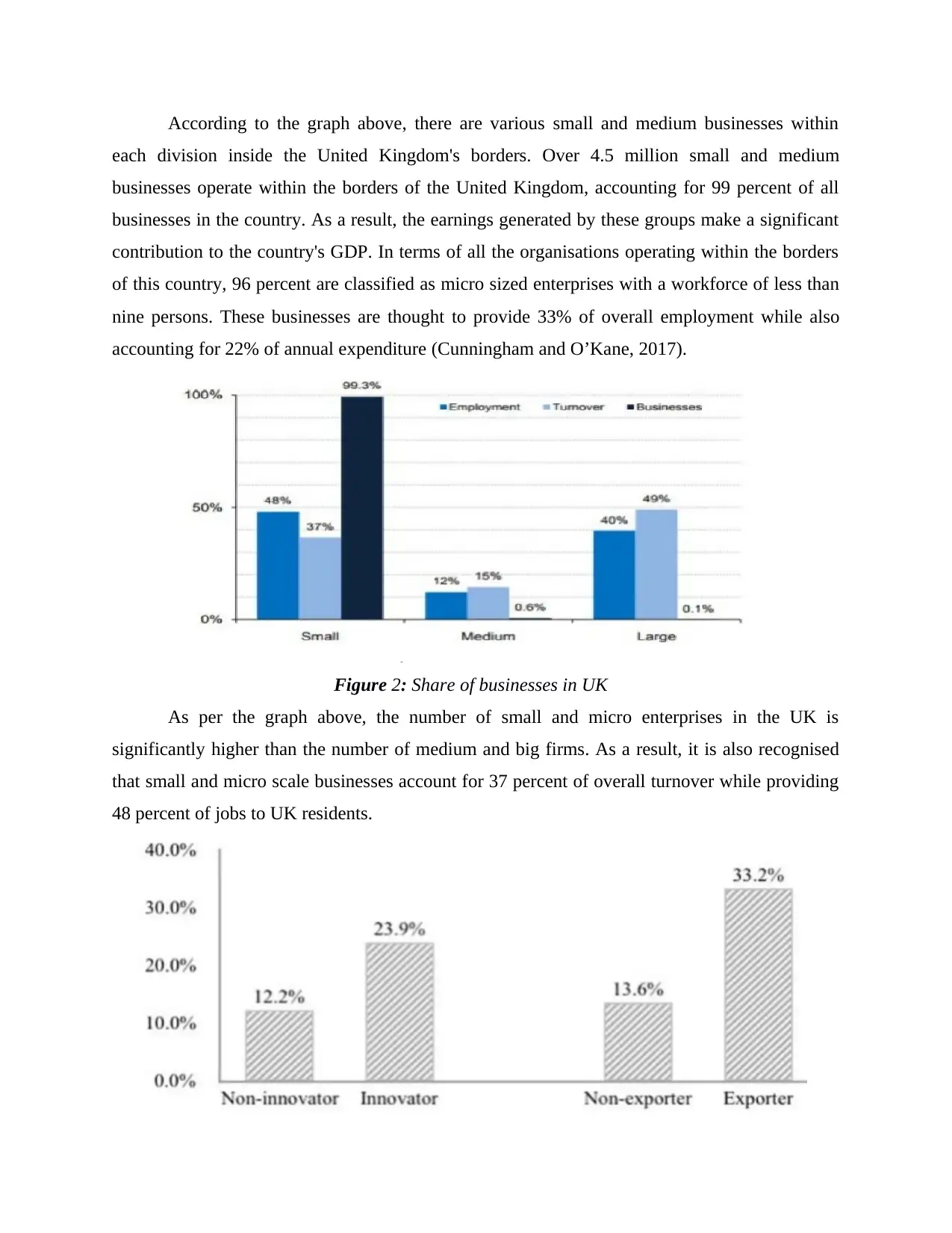
According to the graph above, there are various small and medium businesses within
each division inside the United Kingdom's borders. Over 4.5 million small and medium
businesses operate within the borders of the United Kingdom, accounting for 99 percent of all
businesses in the country. As a result, the earnings generated by these groups make a significant
contribution to the country's GDP. In terms of all the organisations operating within the borders
of this country, 96 percent are classified as micro sized enterprises with a workforce of less than
nine persons. These businesses are thought to provide 33% of overall employment while also
accounting for 22% of annual expenditure (Cunningham and O’Kane, 2017).
Figure 2: Share of businesses in UK
As per the graph above, the number of small and micro enterprises in the UK is
significantly higher than the number of medium and big firms. As a result, it is also recognised
that small and micro scale businesses account for 37 percent of overall turnover while providing
48 percent of jobs to UK residents.
each division inside the United Kingdom's borders. Over 4.5 million small and medium
businesses operate within the borders of the United Kingdom, accounting for 99 percent of all
businesses in the country. As a result, the earnings generated by these groups make a significant
contribution to the country's GDP. In terms of all the organisations operating within the borders
of this country, 96 percent are classified as micro sized enterprises with a workforce of less than
nine persons. These businesses are thought to provide 33% of overall employment while also
accounting for 22% of annual expenditure (Cunningham and O’Kane, 2017).
Figure 2: Share of businesses in UK
As per the graph above, the number of small and micro enterprises in the UK is
significantly higher than the number of medium and big firms. As a result, it is also recognised
that small and micro scale businesses account for 37 percent of overall turnover while providing
48 percent of jobs to UK residents.
⊘ This is a preview!⊘
Do you want full access?
Subscribe today to unlock all pages.

Trusted by 1+ million students worldwide
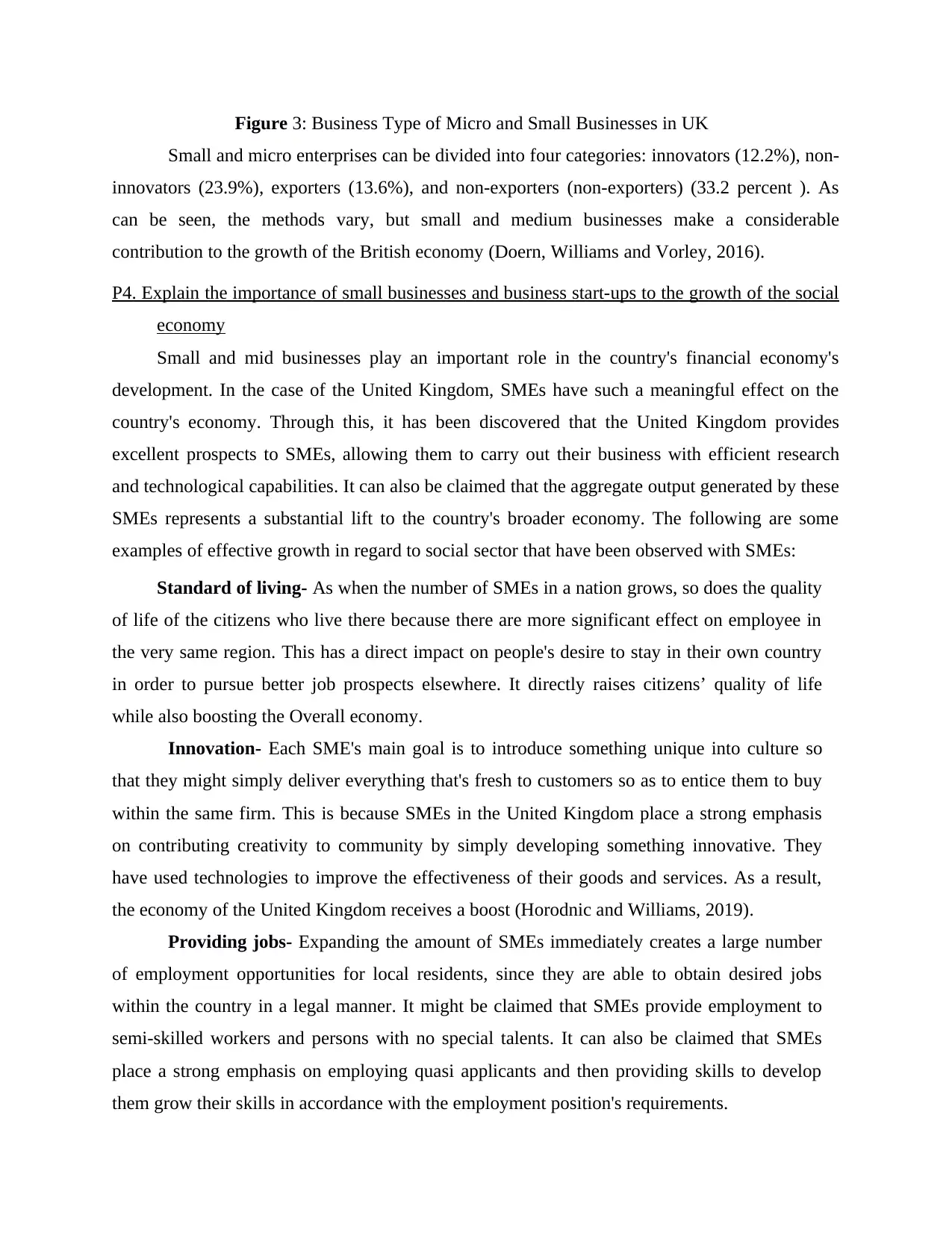
Figure 3: Business Type of Micro and Small Businesses in UK
Small and micro enterprises can be divided into four categories: innovators (12.2%), non-
innovators (23.9%), exporters (13.6%), and non-exporters (non-exporters) (33.2 percent ). As
can be seen, the methods vary, but small and medium businesses make a considerable
contribution to the growth of the British economy (Doern, Williams and Vorley, 2016).
P4. Explain the importance of small businesses and business start-ups to the growth of the social
economy
Small and mid businesses play an important role in the country's financial economy's
development. In the case of the United Kingdom, SMEs have such a meaningful effect on the
country's economy. Through this, it has been discovered that the United Kingdom provides
excellent prospects to SMEs, allowing them to carry out their business with efficient research
and technological capabilities. It can also be claimed that the aggregate output generated by these
SMEs represents a substantial lift to the country's broader economy. The following are some
examples of effective growth in regard to social sector that have been observed with SMEs:
Standard of living- As when the number of SMEs in a nation grows, so does the quality
of life of the citizens who live there because there are more significant effect on employee in
the very same region. This has a direct impact on people's desire to stay in their own country
in order to pursue better job prospects elsewhere. It directly raises citizens’ quality of life
while also boosting the Overall economy.
Innovation- Each SME's main goal is to introduce something unique into culture so
that they might simply deliver everything that's fresh to customers so as to entice them to buy
within the same firm. This is because SMEs in the United Kingdom place a strong emphasis
on contributing creativity to community by simply developing something innovative. They
have used technologies to improve the effectiveness of their goods and services. As a result,
the economy of the United Kingdom receives a boost (Horodnic and Williams, 2019).
Providing jobs- Expanding the amount of SMEs immediately creates a large number
of employment opportunities for local residents, since they are able to obtain desired jobs
within the country in a legal manner. It might be claimed that SMEs provide employment to
semi-skilled workers and persons with no special talents. It can also be claimed that SMEs
place a strong emphasis on employing quasi applicants and then providing skills to develop
them grow their skills in accordance with the employment position's requirements.
Small and micro enterprises can be divided into four categories: innovators (12.2%), non-
innovators (23.9%), exporters (13.6%), and non-exporters (non-exporters) (33.2 percent ). As
can be seen, the methods vary, but small and medium businesses make a considerable
contribution to the growth of the British economy (Doern, Williams and Vorley, 2016).
P4. Explain the importance of small businesses and business start-ups to the growth of the social
economy
Small and mid businesses play an important role in the country's financial economy's
development. In the case of the United Kingdom, SMEs have such a meaningful effect on the
country's economy. Through this, it has been discovered that the United Kingdom provides
excellent prospects to SMEs, allowing them to carry out their business with efficient research
and technological capabilities. It can also be claimed that the aggregate output generated by these
SMEs represents a substantial lift to the country's broader economy. The following are some
examples of effective growth in regard to social sector that have been observed with SMEs:
Standard of living- As when the number of SMEs in a nation grows, so does the quality
of life of the citizens who live there because there are more significant effect on employee in
the very same region. This has a direct impact on people's desire to stay in their own country
in order to pursue better job prospects elsewhere. It directly raises citizens’ quality of life
while also boosting the Overall economy.
Innovation- Each SME's main goal is to introduce something unique into culture so
that they might simply deliver everything that's fresh to customers so as to entice them to buy
within the same firm. This is because SMEs in the United Kingdom place a strong emphasis
on contributing creativity to community by simply developing something innovative. They
have used technologies to improve the effectiveness of their goods and services. As a result,
the economy of the United Kingdom receives a boost (Horodnic and Williams, 2019).
Providing jobs- Expanding the amount of SMEs immediately creates a large number
of employment opportunities for local residents, since they are able to obtain desired jobs
within the country in a legal manner. It might be claimed that SMEs provide employment to
semi-skilled workers and persons with no special talents. It can also be claimed that SMEs
place a strong emphasis on employing quasi applicants and then providing skills to develop
them grow their skills in accordance with the employment position's requirements.
Paraphrase This Document
Need a fresh take? Get an instant paraphrase of this document with our AI Paraphraser
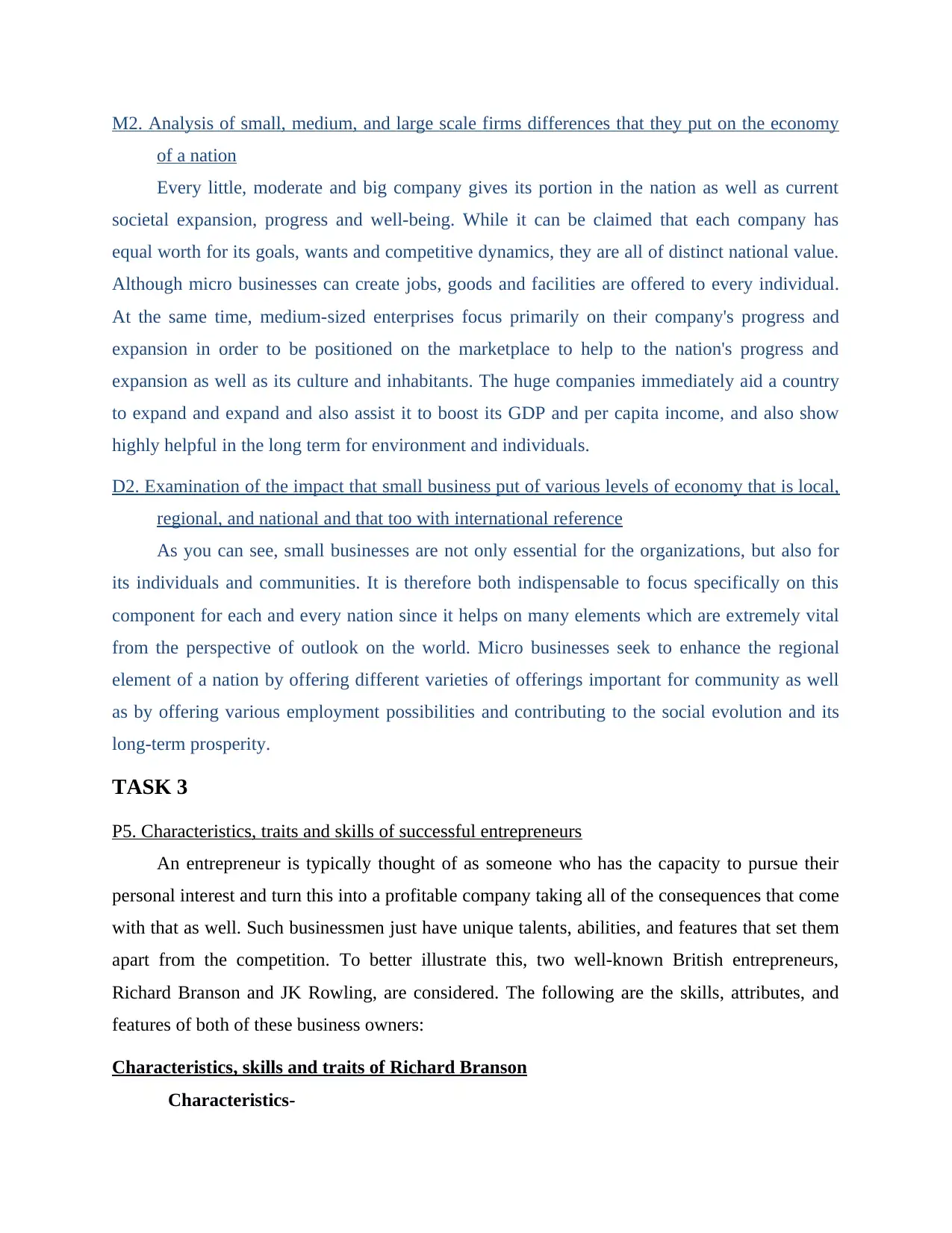
M2. Analysis of small, medium, and large scale firms differences that they put on the economy
of a nation
Every little, moderate and big company gives its portion in the nation as well as current
societal expansion, progress and well-being. While it can be claimed that each company has
equal worth for its goals, wants and competitive dynamics, they are all of distinct national value.
Although micro businesses can create jobs, goods and facilities are offered to every individual.
At the same time, medium-sized enterprises focus primarily on their company's progress and
expansion in order to be positioned on the marketplace to help to the nation's progress and
expansion as well as its culture and inhabitants. The huge companies immediately aid a country
to expand and expand and also assist it to boost its GDP and per capita income, and also show
highly helpful in the long term for environment and individuals.
D2. Examination of the impact that small business put of various levels of economy that is local,
regional, and national and that too with international reference
As you can see, small businesses are not only essential for the organizations, but also for
its individuals and communities. It is therefore both indispensable to focus specifically on this
component for each and every nation since it helps on many elements which are extremely vital
from the perspective of outlook on the world. Micro businesses seek to enhance the regional
element of a nation by offering different varieties of offerings important for community as well
as by offering various employment possibilities and contributing to the social evolution and its
long-term prosperity.
TASK 3
P5. Characteristics, traits and skills of successful entrepreneurs
An entrepreneur is typically thought of as someone who has the capacity to pursue their
personal interest and turn this into a profitable company taking all of the consequences that come
with that as well. Such businessmen just have unique talents, abilities, and features that set them
apart from the competition. To better illustrate this, two well-known British entrepreneurs,
Richard Branson and JK Rowling, are considered. The following are the skills, attributes, and
features of both of these business owners:
Characteristics, skills and traits of Richard Branson
Characteristics-
of a nation
Every little, moderate and big company gives its portion in the nation as well as current
societal expansion, progress and well-being. While it can be claimed that each company has
equal worth for its goals, wants and competitive dynamics, they are all of distinct national value.
Although micro businesses can create jobs, goods and facilities are offered to every individual.
At the same time, medium-sized enterprises focus primarily on their company's progress and
expansion in order to be positioned on the marketplace to help to the nation's progress and
expansion as well as its culture and inhabitants. The huge companies immediately aid a country
to expand and expand and also assist it to boost its GDP and per capita income, and also show
highly helpful in the long term for environment and individuals.
D2. Examination of the impact that small business put of various levels of economy that is local,
regional, and national and that too with international reference
As you can see, small businesses are not only essential for the organizations, but also for
its individuals and communities. It is therefore both indispensable to focus specifically on this
component for each and every nation since it helps on many elements which are extremely vital
from the perspective of outlook on the world. Micro businesses seek to enhance the regional
element of a nation by offering different varieties of offerings important for community as well
as by offering various employment possibilities and contributing to the social evolution and its
long-term prosperity.
TASK 3
P5. Characteristics, traits and skills of successful entrepreneurs
An entrepreneur is typically thought of as someone who has the capacity to pursue their
personal interest and turn this into a profitable company taking all of the consequences that come
with that as well. Such businessmen just have unique talents, abilities, and features that set them
apart from the competition. To better illustrate this, two well-known British entrepreneurs,
Richard Branson and JK Rowling, are considered. The following are the skills, attributes, and
features of both of these business owners:
Characteristics, skills and traits of Richard Branson
Characteristics-
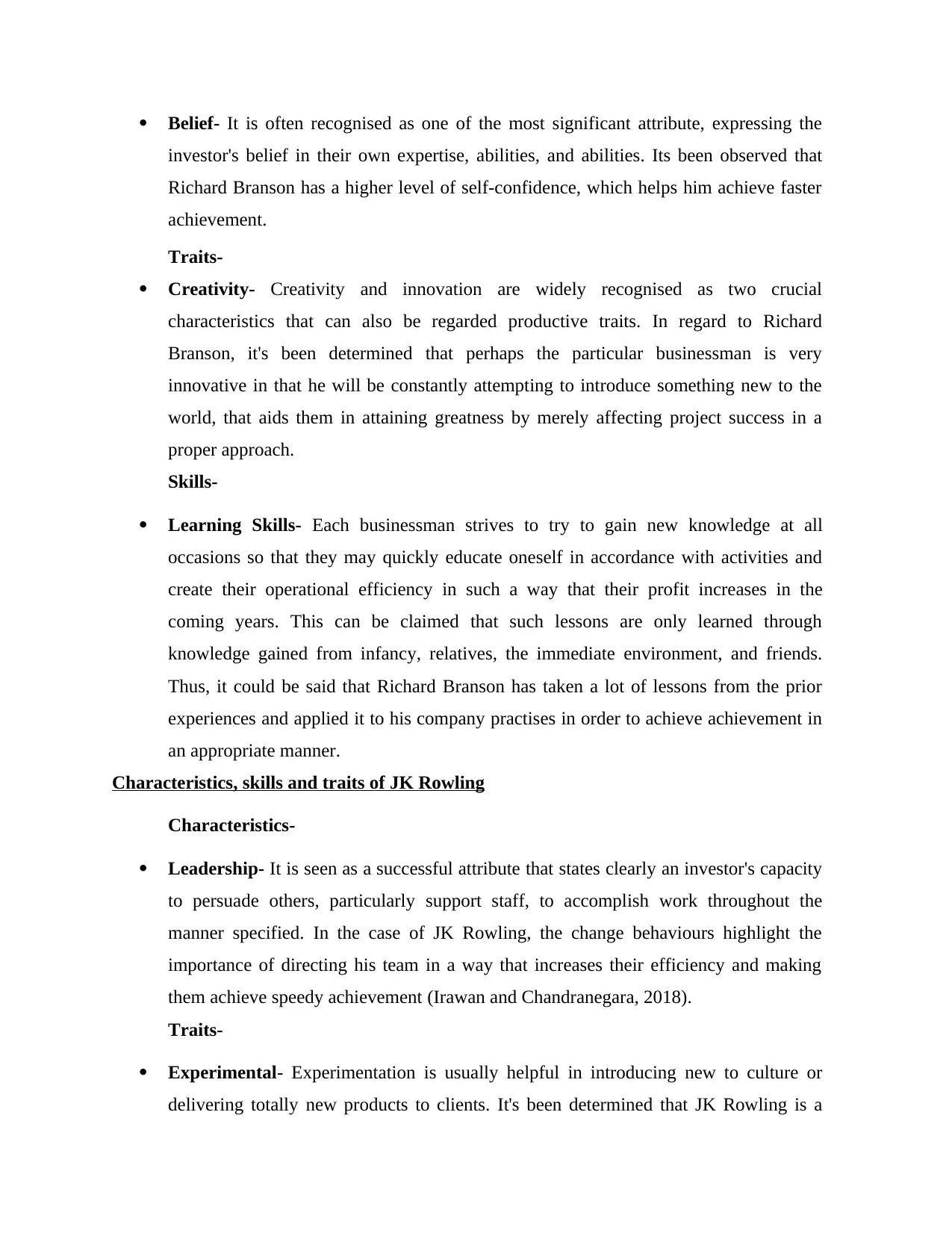
Belief- It is often recognised as one of the most significant attribute, expressing the
investor's belief in their own expertise, abilities, and abilities. Its been observed that
Richard Branson has a higher level of self-confidence, which helps him achieve faster
achievement.
Traits-
Creativity- Creativity and innovation are widely recognised as two crucial
characteristics that can also be regarded productive traits. In regard to Richard
Branson, it's been determined that perhaps the particular businessman is very
innovative in that he will be constantly attempting to introduce something new to the
world, that aids them in attaining greatness by merely affecting project success in a
proper approach.
Skills-
Learning Skills- Each businessman strives to try to gain new knowledge at all
occasions so that they may quickly educate oneself in accordance with activities and
create their operational efficiency in such a way that their profit increases in the
coming years. This can be claimed that such lessons are only learned through
knowledge gained from infancy, relatives, the immediate environment, and friends.
Thus, it could be said that Richard Branson has taken a lot of lessons from the prior
experiences and applied it to his company practises in order to achieve achievement in
an appropriate manner.
Characteristics, skills and traits of JK Rowling
Characteristics-
Leadership- It is seen as a successful attribute that states clearly an investor's capacity
to persuade others, particularly support staff, to accomplish work throughout the
manner specified. In the case of JK Rowling, the change behaviours highlight the
importance of directing his team in a way that increases their efficiency and making
them achieve speedy achievement (Irawan and Chandranegara, 2018).
Traits-
Experimental- Experimentation is usually helpful in introducing new to culture or
delivering totally new products to clients. It's been determined that JK Rowling is a
investor's belief in their own expertise, abilities, and abilities. Its been observed that
Richard Branson has a higher level of self-confidence, which helps him achieve faster
achievement.
Traits-
Creativity- Creativity and innovation are widely recognised as two crucial
characteristics that can also be regarded productive traits. In regard to Richard
Branson, it's been determined that perhaps the particular businessman is very
innovative in that he will be constantly attempting to introduce something new to the
world, that aids them in attaining greatness by merely affecting project success in a
proper approach.
Skills-
Learning Skills- Each businessman strives to try to gain new knowledge at all
occasions so that they may quickly educate oneself in accordance with activities and
create their operational efficiency in such a way that their profit increases in the
coming years. This can be claimed that such lessons are only learned through
knowledge gained from infancy, relatives, the immediate environment, and friends.
Thus, it could be said that Richard Branson has taken a lot of lessons from the prior
experiences and applied it to his company practises in order to achieve achievement in
an appropriate manner.
Characteristics, skills and traits of JK Rowling
Characteristics-
Leadership- It is seen as a successful attribute that states clearly an investor's capacity
to persuade others, particularly support staff, to accomplish work throughout the
manner specified. In the case of JK Rowling, the change behaviours highlight the
importance of directing his team in a way that increases their efficiency and making
them achieve speedy achievement (Irawan and Chandranegara, 2018).
Traits-
Experimental- Experimentation is usually helpful in introducing new to culture or
delivering totally new products to clients. It's been determined that JK Rowling is a
⊘ This is a preview!⊘
Do you want full access?
Subscribe today to unlock all pages.

Trusted by 1+ million students worldwide
1 out of 18
Related Documents
Your All-in-One AI-Powered Toolkit for Academic Success.
+13062052269
info@desklib.com
Available 24*7 on WhatsApp / Email
![[object Object]](/_next/static/media/star-bottom.7253800d.svg)
Unlock your academic potential
Copyright © 2020–2025 A2Z Services. All Rights Reserved. Developed and managed by ZUCOL.





